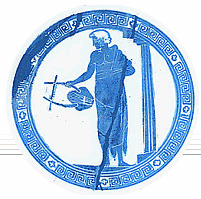|
THE MIDDLE AGES
| MIDDLE AGES
(476-1400) |
 |
|
 |
An age spanning the years from the
fall of the Roman Empire in 476 to around 1400.
Medieval society was conservative and oriented
toward God. The church (the Roman Catholic
church) was the primary patron of art and
education and the single greatest safe guarder
of culture. All music, architecture, poetry and
learning was cultivated by the church. Composers
were churchmen and musicians got their training
as church choirboys. The role of music in the
medieval church was to embellish or accompany
prayer. It was intended to create a mood of
peace, contemplation and spirituality. The
exception of music made in the church were the
popular musicians called troubadours who held
the reputation as wandering musicians. These
wandering entertainers called troubadours or
jongleurs sang their songs and played their
instruments wherever they could find a paying
gig. But it was still the church that preserved
culture and stood against many of the barbaric
conditions that prevailed during the Medieval
Period. Many of the surviving music was composed
anonymously.
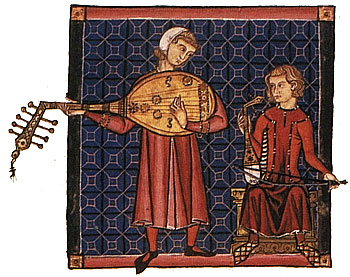 |
 |
Illumination from the
Cantigas de Santa Maria medieval-era
manuscripts.
|
The political system of Europe
during the Middle Ages is called feudalism.
Rulers granted land to certain people under
their authority. These land holders were are
called vassals. In return for the land the
vassals promised to support their rulers in time
of war. The remaining people who lived and
worked on the land were called serfs. Those who
owned the land were called nobles. In addition a
knight or soldier of the noble class was trained
as a horseman and pledged loyalty to a
particular nobleman and in return was granted
land. The church was all that stood against
these harsh conditions and the threat of
diseases and different religious invasions from
the North and from the East.
This was the period in Western
Europe in which musical notation began,
counterpoint was invented around 1000, and some
of the present-day instruments were brought from
Asia and Africa. Gregorian chant or plainsong,
was invented around 500. It was sung as a single
line by a priest and a choir in unison, without
instrumental accompaniment. Around the year
1000, singers began singing Gregorian chant on
its correct pitches others singing it a fourth,
fifth, or octave higher and by the end of the
period, wonderful polyphony was being composed.
Music was an important part of life not only in
the church but also outside of the church
performed by troubadours in castles, village
huts and taverns.
| GREGORIAN
CHANT |
 |
|
 |
|
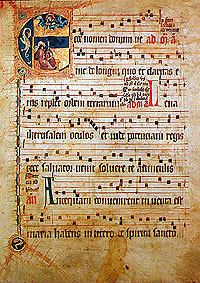
Page
of Chant Sheet Music.
|
The official music of the
Catholic Church during the Middle Ages. It is
also known as plainsong or plainchant. It is
called plainsong because of it's plainness.
Plainchant is in monophonic in texture and it
contains one melodic line without fixed rhythm
(no meter). It is called Gregorian because it is
named after Pope Gregory (540-607) who was
responsible for collecting and codifying the
chant. Gregorian Chant was sung in major church
services especially the during Mass.
Other characteristics of
chant are; a Latin text, modal scale, lack of
clear phrase relationships, peaceful, through
composed, contemplative, meditative, restful,
and prayerful.
Right
click to download!
| ORGANUM |
 |
|
 |
|
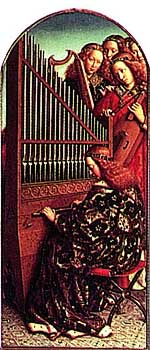
Musicians
by Van Eyk.
|
The
earliest type of notated polyphony. A new note
was added to an existing Gregorian Chant. An
organ often accompanied the singing, hence the
name organum. The Gregorian Chant in an
organum was a slower moving voice and the
second added part was an embellished faster
moving part. The composers choice of the new
note to be added to the existing chant was a
special decision based on what was considered
to be consonant and non-offensive to the
church. The interval of a 3rd or 6th was
considered too sensual and the tritone was
considered the "devil in music." The interval
of a fifth was and in some ways still is the
most important interval in the world. In the
Middle Ages it was considered magical. It is
the first new note in the overtone series.
| MOTET |
 |
|
 |
A sacred
(and sometimes secular) vocal composition based
on Gregorian Chant with 2 or more parts in
polyphonic texture and more independent rhythmic
parts. A medieval motet contains complicated
rhythmic techniques such as isorhythm and
hocket.
A motet also has highly developed polyphony. The
constant experimentation practiced by composers
writing motets resulted in compositions that
sounded odd and sometimes quirky.
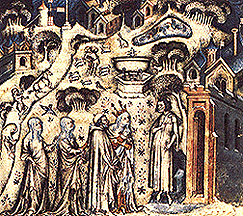 |
 |
Nature présentant
à Machaut ses enfants,
Bibliothèque
nationale de France © BNF
|
This
Motet is written by the French composer
Guillaume de Machaut. Machaut was the first
composer to come up with the idea of writing
music for the 5 parts of the Mass.
| TROUBADOUR |
 |
|
 |
 |
 |
Troubadours, 13th Century
Tirés du
manuscrit des Miracles de saint Louis.
|
A Poet,
composer, and musician of the middle ages who
composed love songs and laments. They came from
Southern France but roamed throughout Europe
from manor to manor or tavern to tavern in seek
of performances for profit and well being. These
type of wandering musicians were called
Trovieres if they came from Northern France,
Minnesingers from Germany and Minstrels from
England.
| ESTAMPIE |
 |
|
 |
 |
 |
Andrea
Da Firenze,
The Church Militant and
Triumphant (detail)
1365-68, Florence.
|
Instrumental
dance music of the Middle Ages consisting of
short simple phrases that repeat over and
over. The dance is lively and consists of
frequent stamping motion, usually in compound
meter.
The
recorded example is played on a rebec (early
violin) and a gittern (early guitar).
The composer is Anonymous.
|
